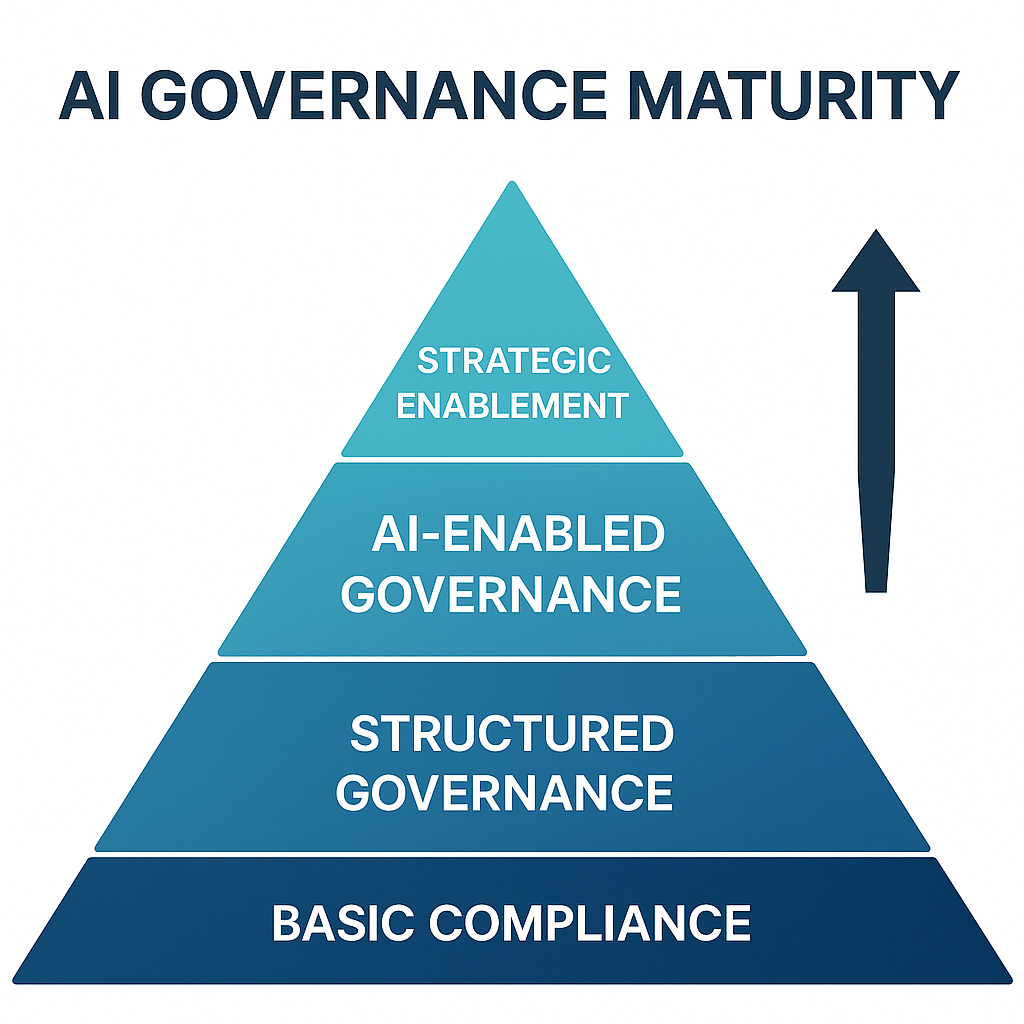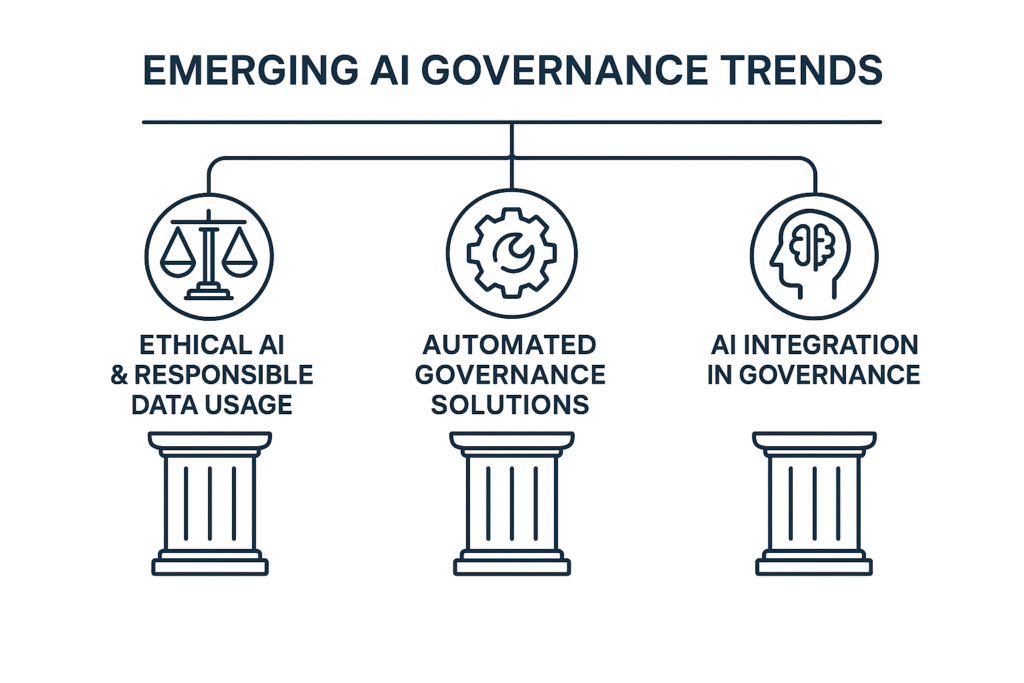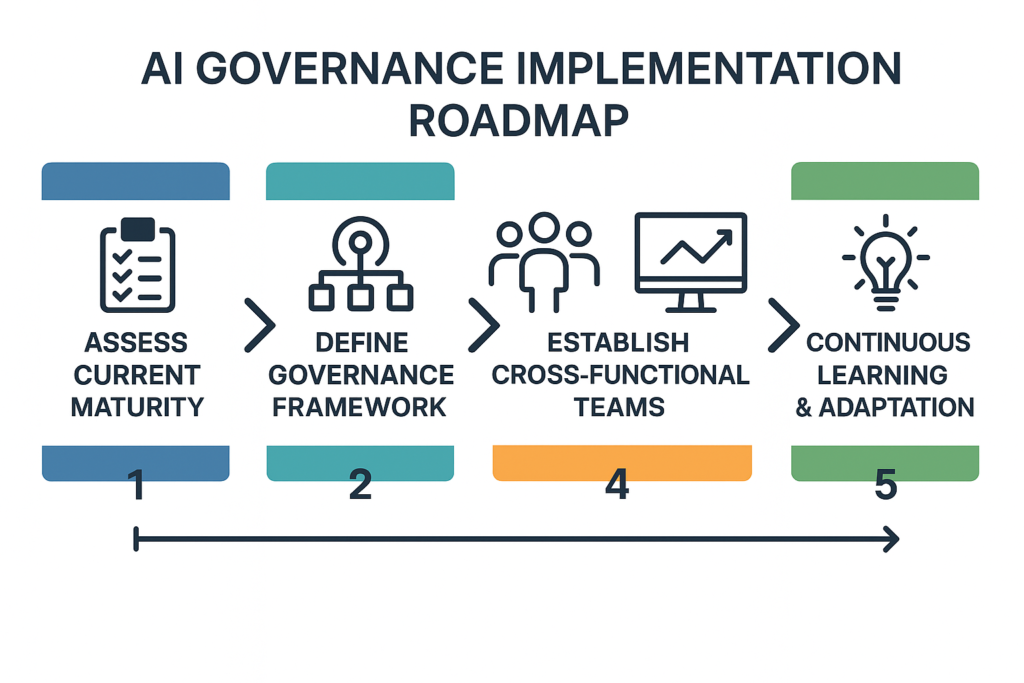AI governance has become one of the most critical strategic considerations for modern enterprises. As someone who has guided organizations through countless technology transformations over the past two decades, I want to share what I’m seeing in the intersection of artificial intelligence and data governance.

As organizations increasingly rely on AI-driven insights and automated decision-making, the traditional approaches to data governance are undergoing a fundamental transformation. For business and IT leaders, understanding these emerging trends in AI governance isn’t just about compliance. It’s about positioning your organization to capture competitive advantages while mitigating risks in an increasingly complex regulatory landscape.
Let me start by helping you understand how the governance paradigm is shifting from reactive compliance to proactive strategic enablement. Traditional governance frameworks, designed for simpler data ecosystems, are struggling to keep pace with the velocity, variety, and volume of modern AI applications.
I’ve watched many organizations discover that their existing governance structures often create bottlenecks that hinder AI innovation rather than enable it. This reminds me of the early days of cloud adoption, when security teams initially resisted the transition until they learned to adapt their frameworks.
This evolution in AI governance is driven by several converging forces: the exponential growth in data generation, the democratization of AI tools across business units, increasing regulatory scrutiny, and growing consumer awareness of data privacy rights. The result is a governance landscape that demands both greater rigor and enhanced agility. This combination requires entirely new approaches to how we think about data stewardship.
The stakes couldn’t be higher. Companies that successfully navigate this transition will unlock unprecedented opportunities for innovation and growth. Those that don’t risk facing significant compliance penalties, reputational damage, and competitive disadvantage as more agile competitors leverage AI capabilities more effectively.
As I’ve shared in our comprehensive guide on AI Implementation Roadmap, the key is building governance frameworks that support rather than hinder innovation.

Emerging Trends Reshaping the AI Governance Landscape
Increased Focus on Ethical AI and Responsible Data Usage
The shift toward ethical AI represents more than just a compliance requirement. It’s becoming a business imperative that directly impacts customer trust, employee engagement, and market positioning. Forward-thinking organizations are discovering that embedding ethical considerations into their AI development processes actually accelerates innovation by providing clearer decision-making frameworks and reducing the risk of costly redesigns.
This trend is manifesting in several practical ways. Companies are establishing AI ethics committees with cross-functional representation, implementing algorithmic auditing processes, and developing explainable AI capabilities that can demonstrate how decisions are made. The business benefit is clear: organizations with robust ethical AI frameworks report higher customer satisfaction scores, improved employee retention, and stronger relationships with regulators.
The competitive advantage extends beyond risk mitigation. Companies that can demonstrate responsible AI practices are finding new opportunities in markets where trust is paramount, such as healthcare, financial services, and government contracting. They’re also attracting top talent who increasingly prioritize working for organizations with strong ethical standards.
Our detailed exploration of AI Governance Importance for Modern Organizations provides practical frameworks for implementing these ethical considerations.
The Rise of Automated Governance Solutions
Manual governance processes that once sufficed for smaller data environments are becoming untenable in AI-driven organizations. The volume and complexity of data flows, combined with the speed of AI model development and deployment, demand automated solutions that can scale with business needs while maintaining consistent oversight.
Modern automated governance platforms are delivering measurable business value through improved efficiency and reduced compliance costs. Organizations implementing these solutions report 60-80% reductions in the time required for data lineage tracking, 50% faster compliance reporting, and significant decreases in data-related incidents. These efficiency gains translate directly to bottom-line benefits, with many companies achieving ROI within 12-18 months of implementation.
The automation trend is also enabling new business models. Companies with robust automated governance can move faster in launching AI-powered products and services, respond more quickly to market opportunities, and operate in highly regulated industries with greater confidence. The agility provided by automated governance is becoming a key differentiator in competitive markets.
Integration of AI in Data Governance Processes
Perhaps the most transformative trend is the application of AI technologies to governance itself. Machine learning algorithms are now being used to automatically classify data, detect anomalies, predict compliance risks, and even suggest governance policies based on usage patterns and regulatory requirements.
This meta-application of AI is proving particularly valuable for organizations dealing with complex, multi-jurisdictional compliance requirements. AI-powered governance tools can continuously monitor data usage across global operations, automatically flagging potential violations and suggesting remediation strategies. The business impact includes reduced legal exposure, faster response to regulatory changes, and more efficient allocation of compliance resources.
Organizations leveraging AI in their governance processes are also gaining deeper insights into their data assets. These tools can identify high-value data sets that are underutilized, suggest optimization opportunities, and help prioritize governance investments based on business impact. The result is a more strategic approach to data management that aligns governance activities with business objectives.
For organizations looking to implement these capabilities, our guide on Data Quality: Leveraging AI Agents for Enterprise Transformation offers practical starting points.
Business Implications of These Transformative Trends
Preparing for Future Regulations and Compliance Requirements
The regulatory landscape for AI governance is evolving rapidly, with new frameworks emerging at local, national, and international levels. Organizations that wait for regulations to be finalized before adapting their governance practices will find themselves at a significant disadvantage. The key is to build governance frameworks that are flexible enough to accommodate new requirements while robust enough to meet current standards.
Leading organizations are taking a proactive approach by establishing governance practices that exceed current requirements. This strategy provides several business benefits: reduced scrambling when new regulations are announced, smoother audits and regulatory interactions, and the ability to enter new markets more quickly. Companies with mature governance frameworks often find themselves helping to shape regulatory discussions rather than simply reacting to them.
The financial implications are substantial. Organizations that are caught unprepared for new regulations face not only direct compliance costs but also potential business disruption, delayed product launches, and restricted market access. Conversely, companies with adaptive governance frameworks can often turn regulatory changes into competitive advantages by moving faster than less-prepared competitors.
Leveraging Trends to Drive Innovation and Growth
The most successful organizations are discovering that robust governance doesn’t constrain innovation. It enables it. By establishing clear guidelines and automated processes, companies can empower their teams to experiment with AI technologies while maintaining appropriate oversight. This balance is crucial for maintaining competitive advantage in fast-moving markets.
The business case for governance-enabled innovation is compelling. Organizations with mature governance frameworks report 40% faster time-to-market for AI-powered products, higher success rates for AI initiatives, and greater confidence in scaling successful pilots. The governance framework provides the foundation for responsible experimentation and rapid scaling of successful innovations.
Moreover, strong governance practices are becoming essential for accessing capital and partnership opportunities. Investors and strategic partners increasingly evaluate governance maturity as a key factor in their decision-making processes. Organizations with demonstrable governance capabilities often enjoy better terms in funding rounds and partnership negotiations.
This aligns with what we discuss in our article on Integrating AI with Your Overall Business Strategy, where governance becomes an enabler rather than a barrier.
Adapting Governance Frameworks to Remain Relevant
Traditional governance frameworks, often built around periodic reviews and manual processes, are inadequate for the speed and complexity of modern AI development. Organizations must evolve toward continuous governance models that provide real-time oversight without slowing down innovation cycles.
This evolution requires rethinking fundamental assumptions about how governance operates. Instead of treating governance as a checkpoint, leading organizations are embedding governance considerations into every stage of the AI development lifecycle. This approach reduces friction, improves compliance outcomes, and enables faster iteration cycles.
The organizational implications extend beyond technology. Companies are restructuring their governance teams to include more technical expertise, establishing new roles like AI ethics officers and data stewards, and creating cross-functional committees that can respond quickly to emerging issues. These organizational changes are essential for maintaining governance relevance in rapidly evolving technological environments.

Actionable Insights for Strategic Leaders
Staying Informed on Industry Developments
The pace of change in AI governance requires a more systematic approach to staying current with industry developments. Organizations that rely solely on reactive approaches to regulatory monitoring often find themselves behind the curve when significant changes occur.
Successful leaders are establishing formal processes for tracking regulatory developments, industry best practices, and emerging technologies. This includes subscribing to relevant publications, participating in industry forums, and maintaining relationships with regulatory bodies and industry associations. The investment in staying informed pays dividends in earlier identification of opportunities and risks.
Consider establishing a governance council that meets regularly to review industry developments and assess their implications for your organization. This council should include representatives from legal, IT, business units, and external advisors who can provide diverse perspectives on emerging trends and their potential business impact.
Investing in Continuous Learning and Adaptation
The skills required for effective AI governance are evolving rapidly, requiring ongoing investment in team development and capability building. Organizations that treat governance training as a one-time event rather than an ongoing process often find their teams unprepared for new challenges as they emerge.
Develop comprehensive training programs that go beyond basic compliance requirements to include emerging best practices, new technologies, and evolving regulatory expectations. This investment should extend beyond the governance team to include business leaders, data scientists, and other stakeholders who interact with governance processes.
The return on this investment extends beyond improved compliance outcomes. Organizations with well-trained governance teams report higher employee satisfaction, better retention of key personnel, and more effective collaboration between governance and business functions. The improved effectiveness of governance processes often pays for the training investment within the first year.
Building Agile Governance Frameworks
The most critical capability for future success is governance agility. The ability to adapt governance practices quickly in response to changing business needs, regulatory requirements, and technological capabilities. This requires rethinking traditional governance architecture to emphasize flexibility and responsiveness.
Start by identifying the core principles that should remain constant regardless of specific circumstances, then build flexible processes and procedures that can be adapted as needed. This approach provides the stability required for consistent decision-making while enabling rapid response to new situations.
Invest in technology platforms that support rapid configuration changes and can accommodate new data types, processing methods, and compliance requirements. The goal is to create a governance infrastructure that can evolve with your business rather than constraining its growth.
Consider implementing pilot programs for new governance approaches before rolling them out across the organization. This allows you to test new methods, identify potential issues, and refine processes before committing to organization-wide changes. The lessons learned from these pilots often prove invaluable when scaling governance improvements.
Embracing the Future of AI Governance
The future of AI governance will be characterized by greater automation, more sophisticated risk management, and tighter integration between governance and business strategy. Organizations that begin preparing now will be positioned to capture the significant advantages these trends offer, while those that delay risk being left behind in an increasingly competitive landscape.
The trends we’ve discussed represent more than operational improvements. They offer pathways to sustainable competitive advantage through improved risk management, faster innovation cycles, and stronger stakeholder relationships.
The time for action is now. The organizations that will thrive in the AI-driven future are those that view governance not as a constraint but as an enabler of innovation and growth. By investing in the capabilities, technologies, and organizational changes needed to excel in this new environment, business leaders can position their companies to capture the enormous opportunities that lie ahead.
Begin by assessing your current governance maturity, identifying the gaps that pose the greatest risks or limit the most valuable opportunities, and developing a roadmap for addressing these areas systematically. The companies that start this journey today will be the ones setting the pace for their industries tomorrow.
If you’re ready to take the next step in your AI governance journey, I encourage you to explore our comprehensive resources at Curated Analytics where we help organizations build the foundations for successful AI implementation.
FAQ
What are the most important trends in AI governance that business leaders should watch?
The three most critical trends in AI governance are the increased focus on ethical AI and responsible data usage, the rise of automated governance solutions, and the integration of AI technologies into governance processes themselves. These trends represent a shift from reactive compliance to proactive strategic enablement, where governance becomes an enabler of innovation rather than a constraint.
How can organizations prepare for future AI governance regulations?
Organizations should build governance frameworks that are flexible enough to accommodate new requirements while robust enough to meet current standards. This involves establishing governance practices that exceed current requirements, creating cross-functional governance committees, and investing in automated governance platforms that can adapt quickly to regulatory changes. The key is to be proactive rather than reactive.
What business benefits can organizations expect from implementing AI governance frameworks?
Organizations with mature AI governance frameworks typically see 40% faster time-to-market for AI-powered products, 60-80% reductions in data lineage tracking time, 50% faster compliance reporting, and significant decreases in data-related incidents. Beyond operational benefits, strong governance practices provide access to new market opportunities, better terms in funding rounds, and the ability to attract top talent.
How should traditional governance frameworks evolve for AI applications?
Traditional governance frameworks must evolve from periodic reviews and manual processes to continuous governance models that provide real-time oversight. This requires embedding governance considerations into every stage of the AI development lifecycle, restructuring governance teams to include technical expertise, and creating cross-functional committees that can respond quickly to emerging issues.
What role does automation play in modern AI governance?
Automation is becoming essential for AI governance due to the volume and complexity of modern data flows. Automated governance platforms can handle data lineage tracking, compliance reporting, anomaly detection, and policy enforcement at scale. Organizations implementing these solutions achieve ROI within 12-18 months while enabling faster innovation cycles and better compliance outcomes.

